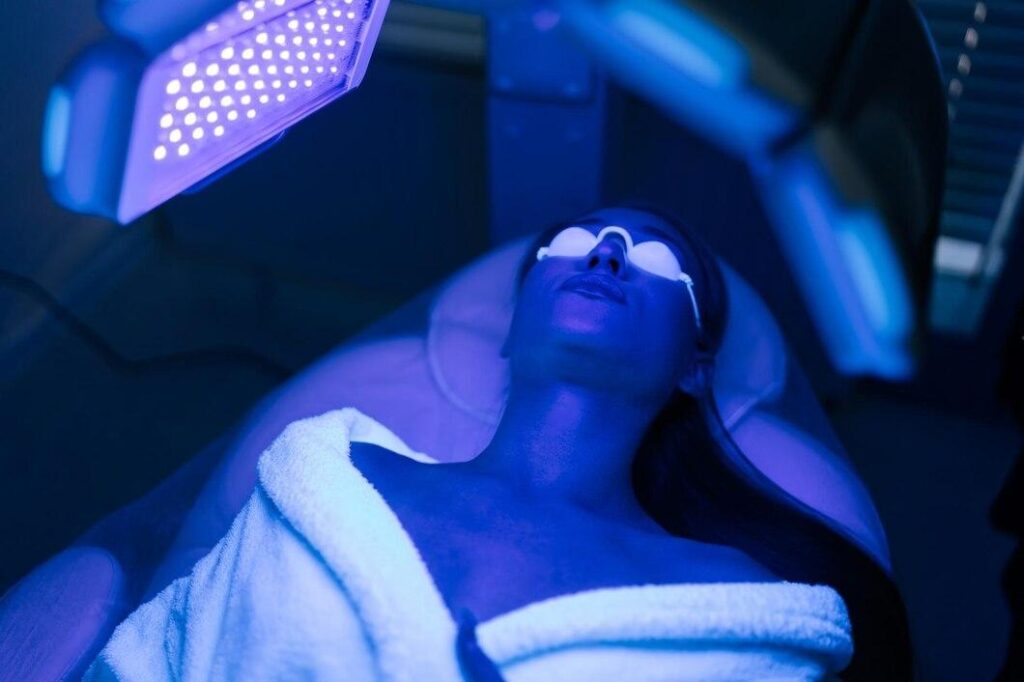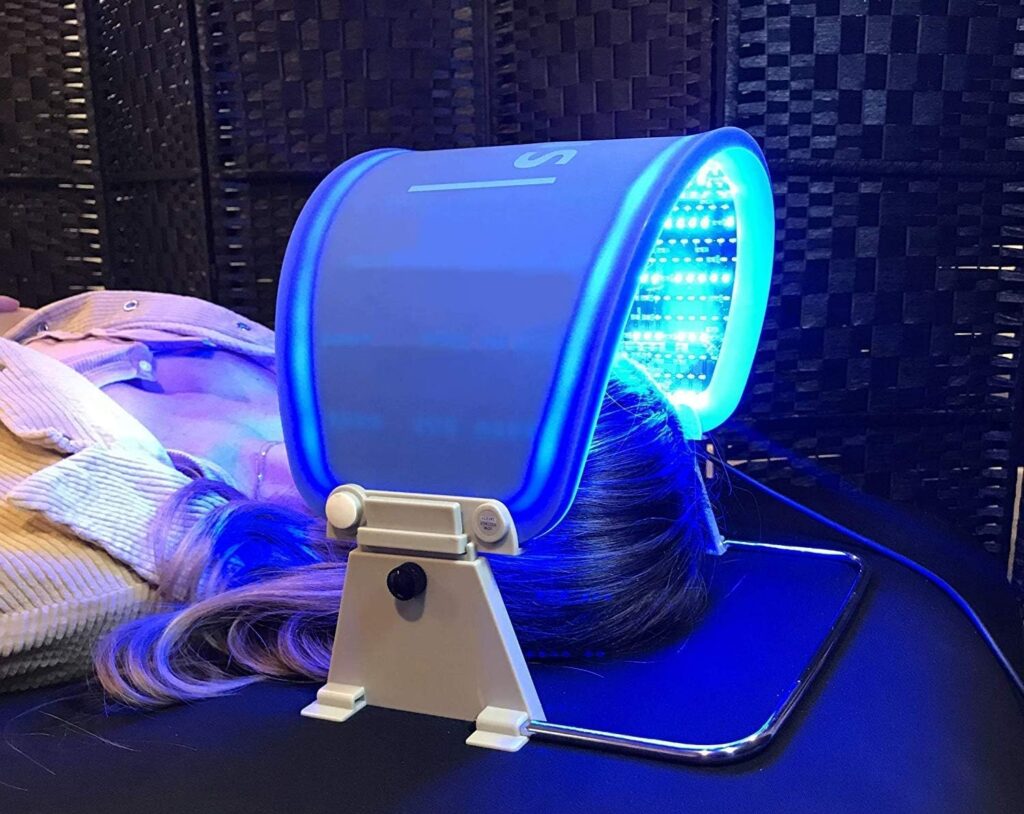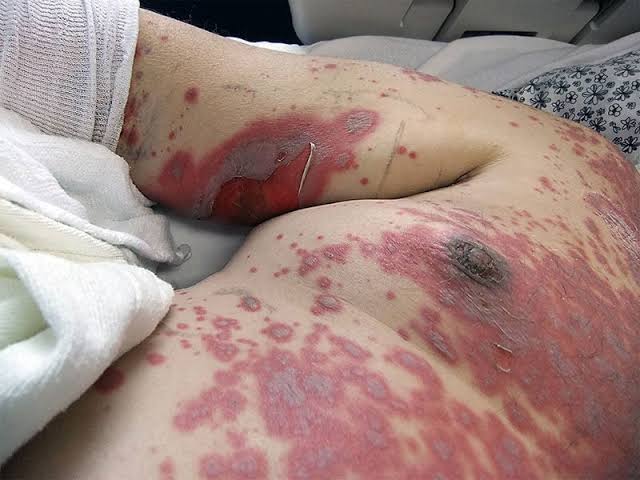
Overview :
Phototherapy stands as a cornerstone in the treatment of various dermatological conditions, harnessing the therapeutic properties of light to promote skin healing and alleviate symptoms. This non-invasive treatment modality has gained widespread acceptance for its efficacy and safety in managing a range of skin disorders.
What is Phototherapy?
Phototherapy, also known as light therapy, involves the exposure of the skin to specific wavelengths of light to achieve therapeutic benefits. This treatment modality utilizes different types of light sources, including ultraviolet (UV) light, to target affected areas of the skin. Phototherapy can be administered in various settings, including specialized clinics, dermatology offices, or even at home under medical supervision.
Indications for Phototherapy:
Phototherapy finds application in the management of several dermatological conditions, including:
- Psoriasis
- Eczema (Atopic Dermatitis)
- Vitiligo
- Pruritus (Itching)
- Cutaneous T-cell Lymphoma
- Acne

Hydraskincare PDT LED Light Photodynamic Facial Skin Care Rejuvenation Photon Therapy Machine
How Does Phototherapy Work?
Phototherapy exerts its therapeutic effects through several mechanisms:
- Anti-inflammatory Action: Certain wavelengths of light, particularly UVB and UVA, possess anti-inflammatory properties that help reduce redness, swelling, and itching associated with skin conditions like psoriasis and eczema.
- Suppression of Immune Response: UV light can modulate the immune response in the skin, leading to decreased inflammation and improved disease control in conditions such as psoriasis.
- Stimulation of Melanocytes: In disorders like vitiligo, phototherapy stimulates the production of melanocytes, the pigment-producing cells in the skin, to help restore normal pigmentation.
Phototherapy: Types, Wavelengths, and Specific Applications:
Phototherapy, a cornerstone in dermatological care, encompasses a diverse array of treatment modalities, each utilizing specific wavelengths of light to target various skin conditions.
1. Ultraviolet B (UVB) Phototherapy
Wavelength Range: UVB phototherapy utilizes wavelengths ranging from 280 to 320 nanometers (nm).
Specific Applications:
- Psoriasis: Both broadband and narrowband UVB phototherapy are effective in treating plaque psoriasis, guttate psoriasis, and other forms of the disease. Narrowband UVB is particularly favored for its higher efficacy and shorter treatment durations.
- Eczema (Atopic Dermatitis): UVB phototherapy, especially narrowband UVB, can help reduce inflammation and itching associated with atopic dermatitis, providing relief for patients who have not responded well to other treatments.
- Vitiligo: UVB phototherapy, including narrowband UVB, is a mainstay treatment for vitiligo, stimulating repigmentation of depigmented areas by activating melanocytes.
2. Ultraviolet A (UVA) Phototherapy
Wavelength Range: UVA phototherapy utilizes wavelengths ranging from 320 to 400 nm.
Specific Applications:
- Psoriasis: PUVA (Psoralen plus UVA) therapy is highly effective in treating psoriasis, especially in patients with extensive or refractory disease. Psoralen sensitizes the skin to UVA radiation, enhancing its therapeutic effects.
- Eczema (Atopic Dermatitis): UVA1 phototherapy has shown promising results in the treatment of atopic dermatitis, particularly in cases resistant to other treatments. It helps reduce inflammation and improve skin barrier function.
- Vitiligo: PUVA therapy is also used in the treatment of vitiligo, especially in patients with widespread or recalcitrant disease. Combined with psoralen, UVA radiation stimulates repigmentation of depigmented skin patches.
3. Blue Light Phototherapy
Wavelength Range: Blue light phototherapy utilizes wavelengths between 405 and 470 nm.
Specific Applications:
- Acne Treatment: Blue light photo therapy is effective in targeting the bacteria associated with acne vulgaris, reducing inflammation and improving the appearance of acne lesions. It is often used as a adjunctive treatment to other acne therapies.
4. Red Light Phototherapy
Wavelength Range: Red light photo therapy typically utilizes wavelengths between 630 and 700 nm.
Specific Applications:
- Wound Healing: Red light phototherapy promotes wound healing by increasing blood flow to the affected area and stimulating cellular repair mechanisms. It is used for chronic wounds, ulcers, and postsurgical incisions, accelerating the healing process.
Administration and Doses:
Photo therapy, a key treatment modality in dermatology, relies on precise dosing to achieve therapeutic benefits while minimizing the risk of adverse effects.
1. Ultraviolet B (UVB) Photo therapy Dosing
UVB phototherapy, whether broadband or narrowband, requires careful consideration of dosing parameters to achieve therapeutic efficacy.
- Initial Dose Determination: The initial UVB dose is determined based on factors such as the patient’s skin type, the severity of the condition being treated, and previous photo therapy experience.
- Minimal Erythema Dose (MED): The minimal erythema dose, defined as the lowest UVB dose that produces minimal skin redness within 24 hours, serves as a reference point for determining subsequent treatment doses.
- Incremental Increases: Treatment doses are gradually increased over time, typically starting at 70-80% of the MED and increasing by increments of 10-20% with each session.
- Maximum Tolerated Dose: The maximum tolerated dose is the highest UVB dose that the patient can tolerate without experiencing excessive skin irritation or burning. This dose varies among individuals and may require adjustment based on treatment response and side effects.
2. Ultraviolet A (UVA) Phototherapy Dosing
UVA phototherapy, including PUVA (Psoralen plus UVA) therapy and UVA1 therapy, also requires careful dosing considerations.
- Psoralen Administration: In PUVA therapy, the psoralen medication is administered either orally or topically before UVA exposure, with dosing determined based on the patient’s weight and individual response.
- UVA1 Dosing: UVA1 therapy typically involves longer exposure times and lower doses compared to PUVA therapy. Treatment doses are gradually increased based on the patient’s tolerance and response to therapy.
3. Blue and Red Light Phototherapy Dosing
Blue and red light phototherapy, used primarily for acne treatment and wound healing, respectively, also require appropriate dosing strategies.
- Blue Light Dosing: Blue light phototherapy for acne treatment typically involves multiple sessions per week over several weeks, with treatment durations ranging from 15 to 30 minutes per session.
- Red Light Dosing: Red light phototherapy for wound healing may vary in duration and frequency depending on the severity and chronicity of the wound. Treatment sessions may last 15 to 30 minutes and are repeated several times per week.
4. Individualized Treatment Plans
In all forms of photo therapy, treatment plans should be individualized based on the patient’s response to therapy, skin type, medical history, and treatment goals. Close monitoring of treatment progress, including regular assessments of skin response and side effects, is essential for optimizing treatment doses and ensuring patient safety.
Side Effects of Phototherapy:
While photo therapy is generally considered safe, potential side effects may include:
- Skin Irritation: Some individuals may experience redness, dryness, or increased sensitivity of the skin following photo therapy sessions.
- Sunburn: Overexposure to UV light can lead to sunburn-like symptoms, including pain, blistering, and peeling of the skin.
- Hyperpigmentation: Prolonged exposure to UV light may cause darkening of the skin, particularly in individuals with darker skin tones.
- Increased Risk of Skin Cancer: Long-term exposure to UV radiation carries a potential risk of skin cancer, necessitating careful monitoring and adherence to recommended treatment protocols.
Alternative Treatment Options:
In cases where photo therapy may not be suitable or effective, alternative treatment options may include:
- Topical Medications: Topical creams, ointments, or gels containing corticosteroids, calcineurin inhibitors, or vitamin D analogs may be prescribed to manage symptoms and control inflammation.
- Systemic Medications: Oral medications, such as retinoids, immunosuppressants, or biologic agents, may be used to treat severe or resistant cases of skin disorders.
Complications and Considerations:
While photo therapy is generally well-tolerated, certain precautions and considerations should be taken into account:
- Eye Protection: Proper eye protection, such as goggles or sunglasses, should be worn during photo therapy sessions to prevent damage to the eyes from UV radiation.
- Pregnancy: Photo therapy may not be recommended during pregnancy due to potential risks to the developing fetus. Pregnant women should consult with their healthcare provider before undergoing photo therapy.
- Skin Type: Individuals with fair skin or a history of sunburn may be more susceptible to side effects from photo therapy and may require adjustments to treatment parameters.
In summary, photo therapy represents a valuable treatment option for various dermatological conditions, offering a safe and effective means of achieving symptom relief and improving skin health.
• Read more :


Very good information